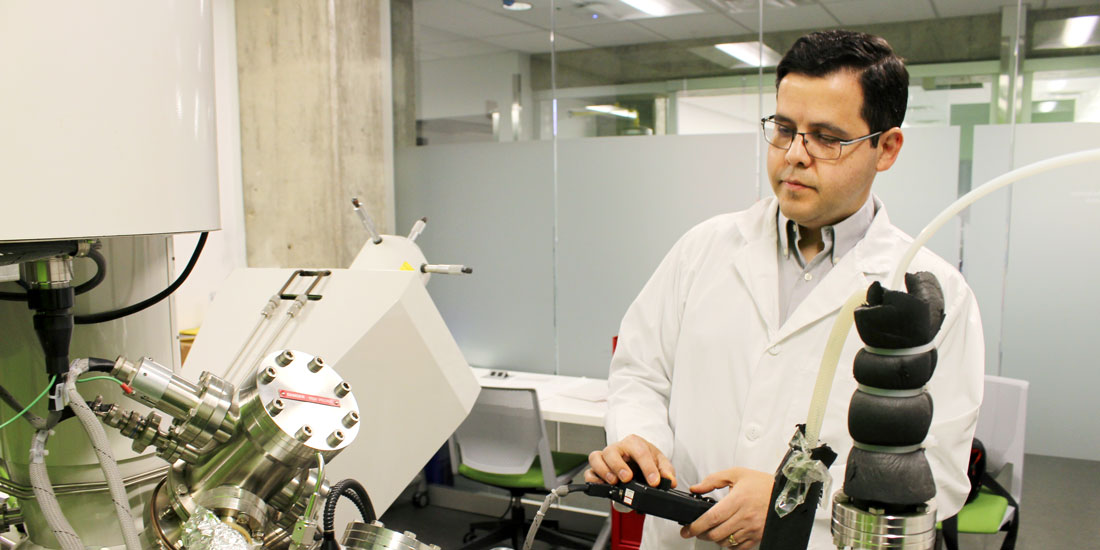
Engineering oral care
Dr. Rodrigo França wants to rid the world of cavities once and for all. The associate professor and division head of dental materials in the Dr. Gerald Niznick College of Dentistry is developing a way to protect pearly whites from decay by using nanoparticles.
“What I’m trying to do is a game-changer,” he says.
França envisions a day when a patient will visit their dentist for a treatment in which nanoparticles are inserted into the patient’s teeth to strengthen and protect them from decay.
The professor, who leads the U of M dental biomaterials research lab, oversaw a study that showed that superparamagnetic iron oxide nanoparticles (SPIONs) can fully penetrate human molars when subjected to an external magnetic field.
That means the tiny particles could carry a drug and be magnetically guided inside the teeth. França hopes to see this groundbreaking practice become a reality in the next five years.
As part of his research, he analyzes the atomic composition of nanoparticles using an X-ray photoelectron spectroscopy (XPS) machine at the Manitoba Institute for Materials on the Fort Garry campus.
“It would be wonderful if we could provide a technique to prevent cavities before they start,” he says. “The first results are very promising.”
França has published articles in international journals and received a number of scientific prizes. Many of his laboratory studies have involved developing, testing and comparing products used in dentistry, such as alloys, ceramics, cements, resins and adhesives.
In one study, he compared the physicochemical properties of seven types of conventional dental implants with experimental implants created through 3D printing technology.
Sometimes he investigates the effect of one material on another. For instance, he has examined the effects of at-home and in-office teethwhitening products on dental cements and composites.
The dentist/scientist views materials as the driving force of oral care improvement. “Everything that changes in dentistry changes because we have new materials,” he says. “We never invent a technique and say, ‘Oh, what material are we going to use here?’ No, it’s the opposite.”
França grew up in a family of lawyers in Divinópolis, a city in southeast Brazil. However, it was biology, not law, to which he was drawn at a young age. He completed his dentistry degree at the University of Itaúna in 1988 and worked as a general dentist before obtaining his master’s and PhD in dental materials from the University of Sao Paulo.
Driven by a passion to innovate, he obtained a second PhD in biomedical engineering at Polytechnique Montréal in 2011.
“I’m half-dentist and half-engineer,” says França, who joined the U of M in 2012. “I learned how to do research with engineers, and I know what dentists need.”
While he supervises graduate student research on nanoparticles, França also oversees projects by dentistry students who do summer research to earn bachelor of science in dentistry degrees. They’re looking at ways to improve dental restorations, such as fillings and crowns. The professor hopes to invent a way to adhere a tooth and a restoration that lasts as long as 20 years.
França recently attained a personal milestone with the release of a book, Dental Biomaterials, co-edited with Dr. Edward Sacher of Polytechnique Montréal and published by the prestigious World Scientific Publishing.
Authorities on dental materials from around the world, as well as U of M experts Dr. Charlene Solomon, Igor Pesun [DMD/87] and Larissa Bubnowicz [B.Sc./11, Dip.D.Hyg./13], contributed as writers.
“The book was two years of very hard work,” França says. “But it’s an accomplishment. It’s an honour.”
Whether it’s working on a book or in a lab, França enjoys collaborating with colleagues, researchers and students. Every year, his lab provides training for academics and students from countries such as Mexico, Brazil, Libya, Nigeria, Saudi Arabia and China.
“Collaboration is the key to success in research, because we are not islands,” he says. “We need to have contact with people who bring different expertise. Everything I do is teamwork.”






